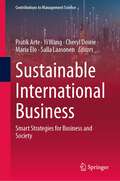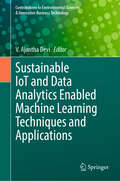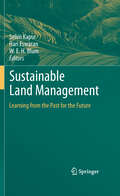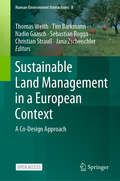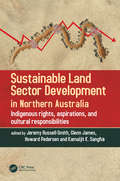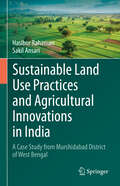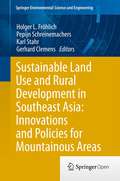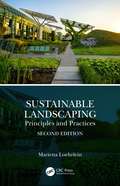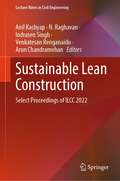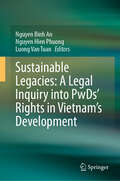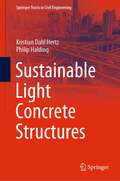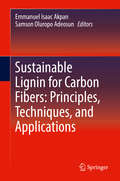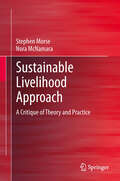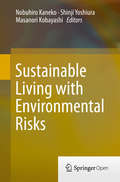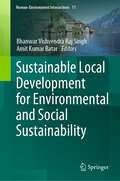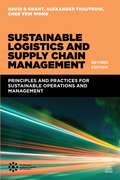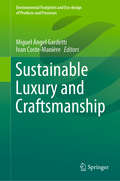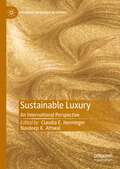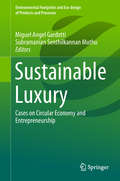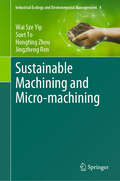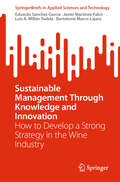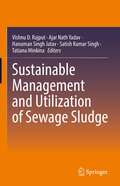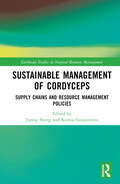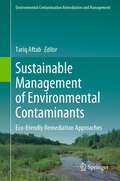- Table View
- List View
Sustainable International Business: Smart Strategies for Business and Society (Contributions to Management Science)
by Yi Wang Maria Elo Pratik Arte Cheryl Dowie Salla LaasonenThis is a unique book that adopts a global approach to studying international business. It stimulates research and rethinking among scholars and practitioners to understand how businesses operate internationally into lucrative markets, and their role in sustainable business growth, glocal value creation, and economic development. It provides insights into how international firms, entrepreneurs, family businesses, and other stakeholders balance the act of value creation and conducting sustainable and ethical business. The book covers economic, social, and environmental dimensions of sustainability such as poverty alleviation through FDI and remittances, diversity and inclusion in management, and ethical governance to value creation for stakeholders and profit maximization through sustainable firm growth, entrepreneurial initiatives, and sustainable business models. It addresses capacity building and the grand challenges that international business needs to develop solutions for. The chapters offer multiple types of contributions including conceptual and theoretical works, literature reviews, and empirical (qualitative and quantitative) studies. The authors, and the topics included, provide a wide international representation and illustrate multi-layered sustainable business perspectives that cover developing, emerging, and developed country contexts as well as multiple directions of international business flows.
Sustainable IoT and Data Analytics Enabled Machine Learning Techniques and Applications (Contributions to Environmental Sciences & Innovative Business Technology)
by V. Ajantha DeviThis book provides a structured presentation of machine learning related to vision, speech, and natural language processing. It addresses the tools, techniques, and challenges of machine learning algorithm implementation, computation time, and the complexity of reasoning and modeling of different types of data. The book covers diverse topics such as semantic image segmentation, deep visual residual abstraction, brain–computer interfaces, natural language processing, traffic and signaling, driverless driving, and radiology. The majority of smart applications have a need for a sustainable Internet of things (IoT) and artificial intelligence. Active research trends and future directions of machine learning under big data analytics are also discussed. Machine learning is a class of artificial neural networks that have become dominant in various computer vision tasks, attracting interest across a variety of domains as they are a type of deep neural networks efficient in extracting meaningful information from visual imagery.
Sustainable Land Management
by Selim Kapur Hari Eswaran Winfried E.H. BlumSoil quality is threatened by many human-induced activities, but can also be improved by good land management. In the relatively short history of mankind on earth, the landscape and soils of the world have been drastically modified from their "natural " state. Landscapes altered by man's activities are termed "Anthroscapes" which are inextricably linked to culture and history. The challenges for today's scientists are to devise and implement sustainable land management strategies in order to preserve the land for the benefit of future generations. This book is a valuable compendium of the research experiences so far gained in studies of the context and concept of the "Anthroscape" and highlights the potential future contributions of such research to sustainable development.
Sustainable Land Management in a European Context: A Co-Design Approach (Human-Environment Interactions #8)
by Thomas Weith Tim Barkmann Nadin Gaasch Sebastian Rogga Christian Strauß Jana ZscheischlerThis open access book presents and discusses current issues and innovative solution approaches for land management in a European context. Manifold sustainability issues are closely interconnected with land use practices. Throughout the world, we face increasing conflict over the use of land as well as competition for land.Drawing on experience in sustainable land management gained from seven years of the FONA programme (Research for Sustainable Development, conducted under the auspices of the German Federal Ministry of Education and Research), the book stresses and highlights co-design processes within the “co-creation of knowledge”, involving collaboration in transdisciplinary research processes between academia and other stakeholders. The book begins with an overview of the current state of land use practices and the subsequent need to manage land resources more sustainably. New system solutions and governance approaches in sustainable land management are presented from a European perspective on land use. The volume also addresses how to use new modes of knowledge transfer between science and practice. New perspectives in sustainable land management and methods of combining knowledge and action are presented to a broad readership in land system sciences and environmental sciences, social sciences and geosciences.
Sustainable Land Sector Development in Northern Australia: Indigenous rights, aspirations, and cultural responsibilities
by Jeremy Russell-Smith, Howard Pedersen, Glenn James, and Kamaljit K. SanghaKey Features: Provides clear and authoritative recommendations for managing fire in ecological and social contexts Authors are all international leaders in their fields and include not only academics but also leaders of Indigenous communities Explains Indigenous cultural and knowledge systems to a degree that has rarely been accessible to lay and academic readers outside specialized disciplines like Anthropology Responds to growing need for new approaches to managing human-ecological systems that are in greater sympathy with Australia’s natural environments/climate, and value the knowledge of Indigenous people Timely for scholarly and interest groups intervention, as the Australian government is again looking to ‘develop the north' Sustainable Land Sector Development in Northern Australia sets out a vision for developing North Australia based on a culturally appropriate and ecologically sustainable land sector economy. This vision supports both Indigenous cultural responsibilities and aspirations, as well as enhancing enterprise opportunities for society as a whole. In the past, well-meaning if often misguided policy agendas have failed - and continue to fail - North Australians. This book helps breach that gap by acknowledging and harnessing Indigenous cultural strengths and knowledge systems for looking after the country and its people, as part of a smart, novel and diversified ecosystem services economy.
Sustainable Land Use Practices and Agricultural Innovations in India: A Case Study from Murshidabad District of West Bengal
by Hasibur Rahaman Sakil AnsariThis book discusses sustainable land use practices in relation to agricultural innovation, with a local focus by land size classes on the Murshidabad District of West Bengal. Chapter 1 presents the different aspects of the physical and cultural set-up of the Murshidabad district. Chapter 2 provides a background and overview of sustainable agricultural land use and development. Chapter 3 presents the dynamics of sustainable agricultural land use and cropping patterns at the local level. Chapter 4 discusses the overall agricultural innovations concerning the input and output aspects of a spatial context under different land size classes. Chapter 5 covers the relationship between sustained agricultural land use and agricultural innovations. Chapter 6 analyses agricultural innovations and agricultural land use based on household survey data in selected sample villages. Chapter 7 uses a SWOT analysis to understand contemporary issues and challenges of agriculture innovation.
Sustainable Land Use and Rural Development in Southeast Asia: Innovations and Policies for Mountainous Areas (Springer Environmental Science and Engineering)
by Gerhard Clemens Karl Stahr Pepijn Schreinemachers Holger L. FröhlichThis book is based on the findings of a long-term (2000-2014) interdisciplinary research project of the University of Hohenheim in collaboration with several universities in Thailand and Vietnam. Titled Sustainable Land Use and Rural Development in Mountainous Areas in Southeast Asia, or the Uplands Program, the project aims to contribute through agricultural research to the conservation of natural resources and the improvement of living conditions of the rural population in the mountainous regions of Southeast Asia. Having three objectives the book first aims to give an interdisciplinary account of the drivers, consequences and challenges of ongoing changes in mountainous areas of Southeast Asia. Second, the book describes how innovation processes can contribute to addressing these challenges and third, how knowledge creation to support change in policies and institutions can assist in sustainably develop mountain areas and people's livelihoods.
Sustainable Landscaping: Principles and Practices
by Marietta LoehrleinSustainable landscaping involves a set of practices implemented by landscape practitioners to help solve environmental concerns. Continuing in the tradition of its predecessor, the second edition of Sustainable Landscaping: Principles and Practices examines underlying landscaping issues that adversely affect the environment and illustrates alternative methods that result in positive outcomes. This textbook examines all phases of landscaping in both residential and commercial environments, from design to construction and implementation to maintenance. Firmly anchoring landscaping practices in the context of sustainability, this book explores topics including choosing appropriate plants and using plants for specific effects, such as shading, water quality and quantity, soil health and optimal preservation techniques, pesticide usage and its inherent dangers, energy consumption, and resource management and waste reduction. Sustainable Landscaping also provides a thorough grounding in pertinent issues and terminology for each topic, followed by practical solutions applied by landscape professionals. Each chapter includes learning objectives and case studies of actual sustainable landscape activities. Contains updated government statistics and data, graphs, tables, and color photographs throughout. Provides background information and sustainable solutions for students, homeowners, and landscaping professionals to effectively design and manage landscapes. Author Dr. Marietta Loehrlein is a Professor Emeritus of Horticulture and Landscaping at Western Illinois University in Macomb, IL, USA. While there, she developed a new course, "Sustainable Landscaping," and wrote the first edition of this textbook, which was also the first of its kind to address the subject.
Sustainable Lean Construction: Select Proceedings of ILCC 2022 (Lecture Notes in Civil Engineering #383)
by Anil Kashyap N. Raghavan Indrasen Singh Venkatesan Renganaidu Arun ChandramohanThis book presents select proceedings of the Indian Lean Construction Conference (ILCC 2022) with adoption and implementation cases of lean concepts across Indian construction projects. The topics covered are lean culture and behavior, lean in sustainable and green technologies, lean supply chain management and offsite construction, lean in public sector, lean in modern construction techniques, etc. The book also discusses various properties and performance attributes of lean tools and techniques across various construction practices in infrastructure and real estate projects. The book is a valuable reference for researchers and construction professionals interested in Lean Construction.
Sustainable Legacies: A Legal Inquiry into PwDs’ Rights in Vietnam’s Development
by Nguyen Binh An Nguyen Hien Phuong Luong Van TuanThis book offers a comprehensive exploration of Vietnam's legal landscape through the lens of inclusivity. Covering topics ranging from educational rights and workplace inclusivity to corporate social responsibility and transport accessibility, this book provides a nuanced understanding of the challenges and opportunities facing PwDs in Vietnam. What sets this book apart is its interdisciplinary approach, weaving together legal analysis, policy evaluation and real-world case studies to provide practical insights for policymakers, legal practitioners, academics, and advocates. With a focus on actionable recommendations, it is a valuable resource for anyone interested in promoting sustainable development and social justice for persons with disabilities. Accessible yet rigorous, the book is aimed at a wide audience, from legal practitioners and policymakers to disability rights activists and academics. It serves as both a roadmap for legal reform and a catalyst for promoting a more inclusive and just society
Sustainable Light Concrete Structures (Springer Tracts in Civil Engineering)
by Kristian Dahl Hertz Philip HaldingThe book presents new technologies for easy and economical construction of light concrete structures saving materials and CO2. The new super-light technology allows a designer to place forces, where it is optimal, and save material everywhere else. The book also supports this “Direct Engineering” principle with a number of new details and structural principles. The new pearl-chain technology makes it possible to design optimal shapes such as arches, vaults, cupolas, floating tunnels, and shells etc. from inexpensive, and mass-produced components. The new super-light deck-elements presented in the book are now produced in six factories in Denmark, Finland, and USA, and the number is increasing. The book will be of interest for all structural engineers, who would like to save materials, CO2 and optimize their structures, for students learning about the new technologies, and for contractors and architects, who want to investigate new building technologies.
Sustainable Lignin for Carbon Fibers: Principles, Techniques, and Applications
by Emmanuel Isaac Akpan Samson Oluropo AdeosunThis book is designed to provide wide understanding of lignin carbon fiber processes, chemistry, mechanisms, and techniques that will help in further development of lignin carbon fiber for automobile, aerospace, marine, and sports equipment applications. Each step in the processing of lignin carbon fibers is presented as a separate chapter so that issues concerning the processes are exhaustively discussed. Basic scientific principles governing each stage of lignin carbon fiber processing, current state of research and mechanisms behind the processes are illustrated for better understanding. This is the first book to address the entire scope of lignin carbon fiber processing including; extraction, quantification, purification, melt processing, stabilization, carbonization, optimization of processes, and characterization. Presents detailed information on the chemistry, processing, principles and properties of bio-sourced lignin for carbon fiber production;Highlights techniques of recovery and properties of lignin from agricultural waste sources;Addresses applications in automobile, aircraft, marine, and sport industries;Provides insight into the lignin complex macromolecular system, the role of lignin chemistry as it relates to carbon fiber production and the evolution of lignin carbon fiber structure during processing.
Sustainable Livelihood Approach
by Stephen Morse Nora McnamaraWe all view the ubiquitous term 'sustainability' as a worthwhile goal. But how can we apply the principles of sustainability in the real world, at the sharp end of communities in developing nations where income insecurity is the troubled norm? This volume provides some practical answers, explaining the precepts of the 'sustainable livelihood approach' (SLA) through the case study of a microfinance scheme in Africa. The case study, centered around the work of the Catholic Church's Diocesan Development Services organization, involved an SLA implemented over two years designed in part to help enhance its existing microfinance operation through closer links between local communities and international donors. The book's central conclusion is that we must move beyond the concept of sustainable livelihood itself, with its in-built polarities between developed and developing nations, and embrace a more global notion of 'sustainable lifestyle'; a more nuanced and inclusive approach that encompasses not just how we make a sustainable living, but how we can live sustainable lives.
Sustainable Living Solutions: Renewable Energy and Engineering (Advances in Science, Technology & Innovation)
by Ivan A. Parinov D. Jude Hemanth Hasim Altan Ilaria Pigliautile Etleva Dobjani Vincenzo Paolo Bagnato Enkelejda Kucaj Antonio LabalestraThis book includes topics that explore diverse and innovative aspects of architectural design, urban planning, infrastructure, and engineering. The "Values Trilogy Design Philosophy" emphasizes the harmonious integration of sustainability, cost-effectiveness, and artistic expression in architectural projects. "DIGIT-ACCESS" explores a digital gateway to enhance accessibility to heritage architectures. The influence of biomimicry and biophilia on sustainable urban planning is examined, along with the application of biomimetic approaches in smart city design and traditional architecture in Saudi Arabia's Asir region. An analytical study investigates zero-energy concepts in high-rise buildings, while another contrasts the thermal performance of various insulation systems in hot-desert climates. The role of interior design in fostering creativity and cultural enrichment in performance arts academies is highlighted, alongside an architectural appraisal of user perceptions toward Tamil Nadu Housing Board (TNHB) low-income housing schemes. In the realm of electrical, mechanical engineering, and fabrication, this book covers advanced topics such as reducing peak average power ratio in OFDM systems for cognitive radio, nonlinear buckling analyses of corrugated steel plate shear walls, and accelerated corrosion testing of carbon steel. The mechanical characteristics of sustainable rigid pavement using sintered fly ash aggregate are explored, as well as the impact of fiberglass reinforced concrete on sustainable design. Additional studies include the evaluation of water resistance in glass-modified concrete, the effects of laser treatment on waste poly(aramid) fiber for 3D printed composites, and the polymerization of copperas into polyferric sulfate for leachate treatment. Lastly, a thermogravimetric evaluation and kinetic study of pyrolysis in commercialized timber species in Peru provide insights into sustainable material behavior.
Sustainable Living with Environmental Risks
by Nobuhiro Kaneko, Shinji Yoshiura and Masanori KobayashiWe are not free from environmental risks that accompany the development of human societies. Modern economic development has accelerated environmental pollution, caused loss of natural habitats, and modified landscapes. These environmental changes have impacted natural systems: water and heat circulation, nutrient cycling, and biodiversity. These changes in natural systems degrade ecosystem services and subsequently increase environmental risks for humans. Environmental risks, therefore, are not only human health risks by pollution, climatic anomalies and natural disasters, but also degradation of ecosystem services on which most people are relying for their lives. We cannot entirely eliminate the risks, because it is not possible to attain zero impact on the environment, but we need to find a mechanism that minimizes environmental risks for human sustainably. This is the idea of the interdisciplinary framework of “environmental risk management” theory, which advocates harmony between economic development and environmental conservation. Based on this theory, the Sustainable Living with Environmental Risk (SLER) programme, adopted by the Japanese Ministry of Education (MEXT) as one of its strategic programmes, has been training graduate students at the Yokohama National University, Japan, from 2009 to 2013 to become future environmental leaders who will take the initiative in reducing the level of environmental risks and in protecting natural resources in the developing nations of Asia and Africa. This book provides students and teachers of this new academic field with a comprehensive coverage of case studies of environmental risks and their practical management technologies not only in Japan but also in developing nations in Asia and Africa.
Sustainable Local Development for Environmental and Social Sustainability (Human-Environment Interactions #11)
by Bhanwar Vishvendra Raj Singh Amit Kumar BatarThe world organizations, including national governments, have already recognized the importance of the Aichi Biodiversity Target, the Paris Agreement, Sustainable Development Goals (SDGs), Ecosystem-based Disaster Risk Reduction (Eco-DRR), Low Carbon Society. Therefore, there is an urgent need to act locally to tackle socio-economic, socio-ecological, socio-hydrological, and environmental conservation concerns in changing environments on a local to global scale and need to promote scientific solutions and common knowledge to achieve harmony between nature and humans under the threat of global climate change and the post-Covid-19 pandemic situation. For this purpose, the SLD approach is needed towards environmental and social sustainability. However, the SLD approach is challenging in terms of supply and demand of natural resources, resource depletion, socio-economic inequality, biodiversity loss, and climate change risk from local to the global scale, which vary based on different socio-economic, political, geographical, and cultural factors. Therefore, this book will highlight the environmental and social sustainability research by taking the local/regional case study. This book would also highlights the importance of policy interface at a local to global scale for environmental and social sustainability (ESS) in changing environments.
Sustainable Logistics and Supply Chain Management (Revised Edition)
by David B. Grant Chee Yew Wong Alexander TrautrimsAdopting sustainable practices is crucial for all businesses in the 21st century. Sustainable Logistics and Supply Chain Management is the essential guide to the principles and practices of sustainable logistics operations and the responsible management of the entire supply chain. Based on extensive research by experts in the field, this comprehensive book covers the whole scope of sustainable logistics. It provides carefully reviewed research-led applications and case studies that have been especially developed for this revised edition. Examining the subject in an integrated manner, this book examines all the key areas in sustainable logistics, including: sustainable product design and packaging; sustainable purchasing and procurement; cleaner production; environmental impact of freight transport; sustainable warehousing and storage; sustainable supply management; reverse logistics; and recycling; supply chain management strategy, and much more. A vital teaching resource for any course on sustainable logistics, this revised edition of Sustainable Logistics and Supply Chain Management includes valuable supporting online materials, including PPT presentations, chapter summaries, learning objectives, tips for teaching and in class activities.
Sustainable Luxury and Craftsmanship (Environmental Footprints and Eco-design of Products and Processes)
by Ivan Coste-Manière Miguel Ángel GardettiThis book explores the intricate relationship between luxury and craftsmanship, using brand-based case studies and consumer behavior to do so. In addition to revealing how the artification of luxury affects consumer behavior with branding and traditions, it discusses how sustainable luxury could not only offer a vehicle for more respect for the environment and social development, but could also be a metaphor for the cultures, art traditions, and innovations of various nationalities, continuing the legacy of local craftsmanship.
Sustainable Luxury: An International Perspective (Palgrave Advances in Luxury)
by Claudia E. Henninger Navdeep K. AthwalThis book addresses the issue of sustainability in the luxury industry, which has become a major topic of concern for brand managers, scholars, policy-makers, the media, and academia. Spanning 13 chapters, the authors provide insights from developed and developing countries, whilst at the same time exploring a variety of issues within sustainable luxury, the hidden value of secondhand, eco-luxury, circular economy principles and perceptions, ethical sourcing and eco-label strategies. All of which can be linked to the broader theme of SDG12: Responsible Production and Consumption. Thus, the book not only has a wide geographical scope but also brings together a collection of scholars spanning many disciplines such as marketing, management, textiles, fashion, economics, and digital media. Offering a combination of empirical and conceptual works, the book also provides important insights for future research enquiries.
Sustainable Luxury: Cases on Circular Economy and Entrepreneurship (Environmental Footprints and Eco-design of Products and Processes)
by Subramanian Senthilkannan Muthu Miguel Angel GardettiThis book highlights ten cases of entrepreneurship that – in the context of circular economy – have redefined the paradigm of luxury and the notion of exclusivity that it requires. It shows how, by using technology and a new consumption model, the ten companies have created novel business models for luxury, and more intelligent forms of use better-suited to modern times.
Sustainable Machining and Micro-machining (Industrial Ecology and Environmental Management #4)
by Jingzheng Ren Suet To Wai Sze Yip Hongting ZhouThis book explores the technical challenges and technological gaps in sustainable machining and micro-machining. It underscores the critical role of sustainability in manufacturing, a sector pivotal to addressing global environmental challenges. As micro-manufacturing expands, it mirrors traditional manufacturing environmental impact, prompting the need for sustainable strategies. The book delves into methodologies such as network analysis, text mining, and classification algorithms to help readers understand the interplay between machining parameters, stakeholders, and sustainability factors. It concludes with an analysis of the current status and future prospects of sustainable machining and micro-machining. Additionally, it highlights the importance of integrating sustainable manufacturing to enhance efficiency, reduce resource consumption, and meet the increasing demands from society and stakeholders for environmentally responsible manufacturing solutions. Finally, the book examines the current status and future perspectives of sustainable machining and micro-machining, offering a comprehensive view of how industries can reformulate their approaches to ensure continuous development and sustainability.
Sustainable Management Through Knowledge and Innovation: How to Develop a Strong Strategy in the Wine Industry (SpringerBriefs in Applied Sciences and Technology)
by Javier Martínez-Falcó Bartolomé Marco-Lajara Eduardo Sánchez-García Luis A. Millán-TudelaThis book explores multiple types of innovation within the modern wine industry and how it has developed historically. The book provides and extensive examination of the existing knowledge in this subject. This highlights the evolution of historical and contemporary trends and signposts the authoritative literature published and most important researchers active in the field. With this comprehensive approach, the book is a versatile resource for both scholars and industry professionals, akin to a "Swiss Army Knife" for all aspects of green innovation in the wine sector.
Sustainable Management and Utilization of Sewage Sludge
by Ajar Nath Yadav Satish Kumar Singh Vishnu D. Rajput Hanuman Singh Jatav Tatiana MinkinaThis book is devoted to sewage sludge, its sustainable management, and its use and implications on soil fertility and crop production. The book traces the main chemical and biological properties of sewage sludge, and covers topics such as sewage sludge biostabilization and detoxification, biological and thermochemical treatment technologies, emerging nutrient recovery technologies, the role of microorganisms in sewage sludge management, and the sustainable use of sewage sludge as fertilizer in agriculture. The book offers a valuable asset for researchers, scholars and policymakers alike.
Sustainable Management of Cordyceps: Supply Chains and Resource Management Policies (Earthscan Studies in Natural Resource Management)
by Ksenia Gerasimova Jiping ShengThis book examines the challenges of sustainably managing and conserving Cordyceps sinensis, a rare species of fungus largely grown in Tibet, currently on the brink of extinction.As one of the most expensive commodities in the world, particularly valued for its medicinal properties in China, the price of Cordyceps has risen by over 900% since the 1970s. This has made it a very lucrative resource for farmers, many of whom are struggling to produce sufficient food to sustain themselves. Naturally, this has led to overharvesting and, coupled with the impacts of climate change, the crop itself is now at risk. Rarely discussed in Western literature, this book provides a novel examination of Cordyceps, looking into the necessary changes needed to sustainably manage and conserve this important crop. Drawing on extensive field work conducted in Qinghai-Tibet, the book analyzes the supply chain, identifying key issues around production and considering the role and impact of relevant stakeholders. It discusses the necessary changes needed for a sustainable supply change, particularly to stop long-term overharvesting. The book then discusses the role of policy and the institutional management of this resource in China, as one of the main producers and consumers. It analyzes current policy instruments and argues for a more coherent policy which is better orientated towards conservation and sustainable management, rather than solely market regulation.This book will be of great interest to students and scholars of natural resource management, environmental conservation, environmental policy, and sustainable supply chain management.
Sustainable Management of Environmental Contaminants: Eco-friendly Remediation Approaches (Environmental Contamination Remediation and Management)
by Tariq AftabEnvironmental contaminants are chemicals that accidentally or deliberately enter the environment, often, but not always, as a result of human activities. Some of these contaminants may have been manufactured for industrial use, and because they are very stable, they do not break down easily. If released to the environment, these contaminants may enter the food chain. Other environmental contaminants are naturally occurring chemicals, but industrial activity may increase their mobility or increase the amount available to circulate in the environment, allowing them to enter the food chain at higher levels than would otherwise occur. Environmental contaminants influence the physiological cell reactions at different and heterogeneous basics and lead to altering in normal cell function primarily at the molecular and biochemical level. Molecular responses to such common environmental stresses have been studied intensively over the last few years, in which there is an intricate network of signaling pathways controlling perception of these environmental stress signals, the generation of second messengers and signal transduction. Recent advances in many areas of plant and microbial research, including genotyping, make scientists optimistic that valuable solutions will be found to allow deployment/commercialization of strategies better able to tolerate these environmental stresses.Environmental remediation was historically viewed as an inherently sustainable activity, as it restores contamination; however, researchers and practitioners are increasingly recognizing that there can be substantial environmental footprints and socioeconomic costs associated with remediation. Sustainability is an imperative in the emerging green and sustainable remediation movement, which is reshaping the entire remediation industry.Understanding the significant roles of sustainable or eco-friendly approaches in mitigating environmental contaminants, the current subject has recently attracted the attention of scientists from across the globe. This comprehensive volume “Sustainable Management of Environmental Contaminants: Eco-friendly Remediation Approaches" highlights the various prospects involved in current scenario. The current volume comprises the chapters from diverse areas dealing with biotechnology, microbial technology, nanotechnology, molecular biology, green and sustainable remediation, etc. I am hopeful that this volume will furnish the requisite of all those who are working or have interest in the current topic.
